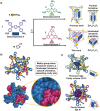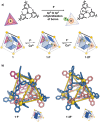Fluoride Enhances Alcohol Binding Within a Trigonal-Prismatic Metal-Organic Capsule
- PMID: 40344164
- PMCID: PMC12258696
- DOI: 10.1002/anie.202505137
Fluoride Enhances Alcohol Binding Within a Trigonal-Prismatic Metal-Organic Capsule
Abstract
Herein we utilize the binding of fluoride to boron atoms to functionalize the interior of a boron-containing trigonal prismatic capsule that incorporates two triangular and three rectangular ligands, enabling the tuning of its guest binding properties. The methyl groups of the triangular ligands guide the rectangular ligands to adopt a "landscape" orientation to avoid steric hindrance. This small structural change gives rise to an enlarged interior cavity volume for guest encapsulation, as compared with a previously-reported trigonal prismatic capsule, where the same rectangular ligand took a "portrait" orientation with a non-methylated triangular ligand of similar size. The methylated triangular ligand contains a boron core, which can bind fluoride ions that point inward. These bound fluorides serve as hydrogen bond acceptors, which increases the affinity of the capsule for hydrogen-bond-donating alcohols, which are bound in preference to ketones of similar sizes. Moreover, this boron-containing trigonal prism selectively binds perrhenate over perchlorate, while fluoride binding modulates the cavity charge, leading to perrhenate ejection. These and similar endo-functionalized capsules may thus be of use in the fields of molecular recognition and separation.
Keywords: Endo‐functionalization; Host–guest chemistry; Metal‐organic cages; Post‐assembly modification; Self‐assembly.
© 2025 The Author(s). Angewandte Chemie International Edition published by Wiley‐VCH GmbH.
Conflict of interest statement
The authors declare no conflict of interest.
Figures



Similar articles
-
Sexual Harassment and Prevention Training.2024 Mar 29. In: StatPearls [Internet]. Treasure Island (FL): StatPearls Publishing; 2025 Jan–. 2024 Mar 29. In: StatPearls [Internet]. Treasure Island (FL): StatPearls Publishing; 2025 Jan–. PMID: 36508513 Free Books & Documents.
-
Portion, package or tableware size for changing selection and consumption of food, alcohol and tobacco.Cochrane Database Syst Rev. 2015 Sep 14;2015(9):CD011045. doi: 10.1002/14651858.CD011045.pub2. Cochrane Database Syst Rev. 2015. PMID: 26368271 Free PMC article.
-
Can a Liquid Biopsy Detect Circulating Tumor DNA With Low-passage Whole-genome Sequencing in Patients With a Sarcoma? A Pilot Evaluation.Clin Orthop Relat Res. 2025 Jan 1;483(1):39-48. doi: 10.1097/CORR.0000000000003161. Epub 2024 Jun 21. Clin Orthop Relat Res. 2025. PMID: 38905450
-
Cost-effectiveness of using prognostic information to select women with breast cancer for adjuvant systemic therapy.Health Technol Assess. 2006 Sep;10(34):iii-iv, ix-xi, 1-204. doi: 10.3310/hta10340. Health Technol Assess. 2006. PMID: 16959170
-
Interventions targeted at women to encourage the uptake of cervical screening.Cochrane Database Syst Rev. 2021 Sep 6;9(9):CD002834. doi: 10.1002/14651858.CD002834.pub3. Cochrane Database Syst Rev. 2021. PMID: 34694000 Free PMC article.
References
-
- Yamada T., Bork P., Nat. Rev. Mol. Cell Biol. 2009, 10, 791–803. - PubMed
-
- Huppa J. B., Davis M. M., Nat. Rev. Immunol. 2003, 3, 973–983. - PubMed
-
- Yudushkin I. A., Schleifenbaum A., Kinkhabwala A., Neel B. G., Schultz C., Bastiaens P. I. H., Science 2007, 315, 115–119. - PubMed
-
- Zürcher M., Diederich F., J. Org. Chem. 2008, 73, 4345–4361. - PubMed
-
- Cremer P. S., Flood A. H., Gibb B. C., Mobley D. L., Nat. Chem. 2018, 10, 8–16. - PubMed
Grants and funding
LinkOut - more resources
Full Text Sources

